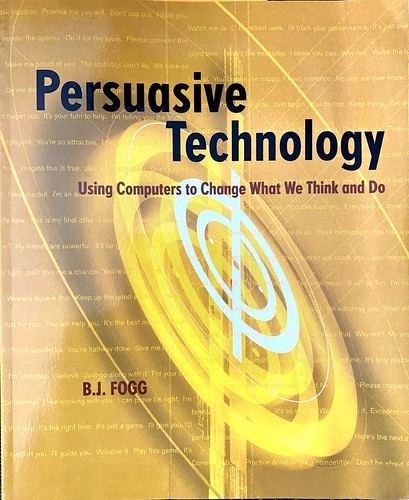4 minutes estimated reading time
Persuasive Technology was published in 2003. It is still the bible for captology ( from Computers as Persuasive Techologies). Back when I was working inhouse at Yahoo!; copies of the book could be found on the desks of some product managers and designers. It has since gained a certain amount of notoriety. Questions are asked around the addictive behaviour of social network and gaming app users. Some consumers even find it hard to stop swiping dating apps.
Fogg realised that computers offered new challenges and opportunities. Persuasive Technology was written almost 20 years ago. How well does it now hold up?
Relevant content
Right from the start when Fogg starts going into the advantages of persuasive technology you can see the evergreen nature of the content.
Some of the content is quite prescient with a section on surveillance technology creating persuasion through observation. The comments on simulation are equally applicable to modern VR environments, which has been proven in the treatment of PTSD amongst combat veterans. The application ‘In My Steps’ (page 76) designed to facilitate empathy among doctors for cancer patients echoes through the patient centric work that pharma companies are currently funding.
Chapter 5 on computers as persuasive social actors is playbook for the way modern apps from freemium games to Tinder work effectively. If you don’t read anything else read this chapter.
Tired?
A cursory skim of the book would yield examples that are Windows Vista-era screenshots of crude applications. You have to remember that the book was written before mainstream social networks or the New York Times paywall. Back then, it was right at the end of the banner ad golden age in online advertising; surviving on ads was still considered an option for news media.
Whilst the context has changed around the web and the way that we use it; the examples are still illustrative. They’re worthwhile sticking with when reading though the book.
Misinformation
The modern issue of misinformation gets a relatively small mention. Fogg realised the impact that misinformation could have on future computer credibility. He felt that as computers lost their ‘aura, their mystique, their presumed credibility’. He thought that computing ubiquity would make computing credibility more complex due to purpose and form-factor.
He also worried about bad actors; though this largely seems due to hacker Adrian Lamo hacked the Yahoo! News content management system from his browser and was able to alter the quotes in stories. At the time subtly altering mainstream news stories was seen as the greatest risk
…Peter Sommer, an expert in computer crime at the London School of Economics, says that carefully changing information posted to a major web site could be far more serious.
“If it is done in a subtle way then this could spread misinformation,” Sommer told New Scientist. “It’s unfortunate that Yahoo! is the largest and most important portal in the world.”
Yahoo! is one of the most popular destinations on the internet. In June 2001 the site had more than 200 million visitors. Yahoo! takes news feeds from a wide range of news agencies and web sites.
Lamo says he was disturbed to have had access to the system during recent terrorist attacks on America, when internet news sites were in great demand.
“At that point I had more potential readership than the Washington Post,” Lamo told Security Focus. “It could have caused a lot of people who were interested in the day’s events a lot of unwarranted grief if false and misleading information had been put up.”
Hacker re-writes Yahoo! news stories – New Scientist (September 20, 2001)
In some ways Fogg’s vision came true. The Macedonian fake news publishing during the 2016 US election wasn’t driven by bad actors; but ad revenue hungry teens. The effect was the same as Lamo’s Yahoo! News hack a decade and a half earlier.
Ethics
The thinking in Persuasive Technology was weaponised in various products and services. Yet, the book, was ethically driven by design. Fogg had a good understanding of how his work could be used by bad actors. He devoted a whole chapter to the ethics of captology and pointed out times when an act would be unethical throughout the book. Fogg starts off with ethics in the preface on page XXVI right before the acknowledgements section.
Chapter 9 goes into the various ethical pitfalls that may await the designer and the user. It’s interesting that many of the case studies focus on getting personal information out of children. Protecting children online has consistently been an issue since the start of the commercial web.
It is also interesting in this chapter that he emphasises the role of education in protecting future users from the unscrupulous.
Conclusion
Yes rereading Persuasive Technology was like taking a time machine back to the post dot com bust web. But the lessons to be learned are still the same. We might have more stylish web design and responsive pages; but we still have the same problems. Whether you work in digital transformation, user experience or content strategy, this book deserves a place on your bookshelf
More book reviews can be found here.
